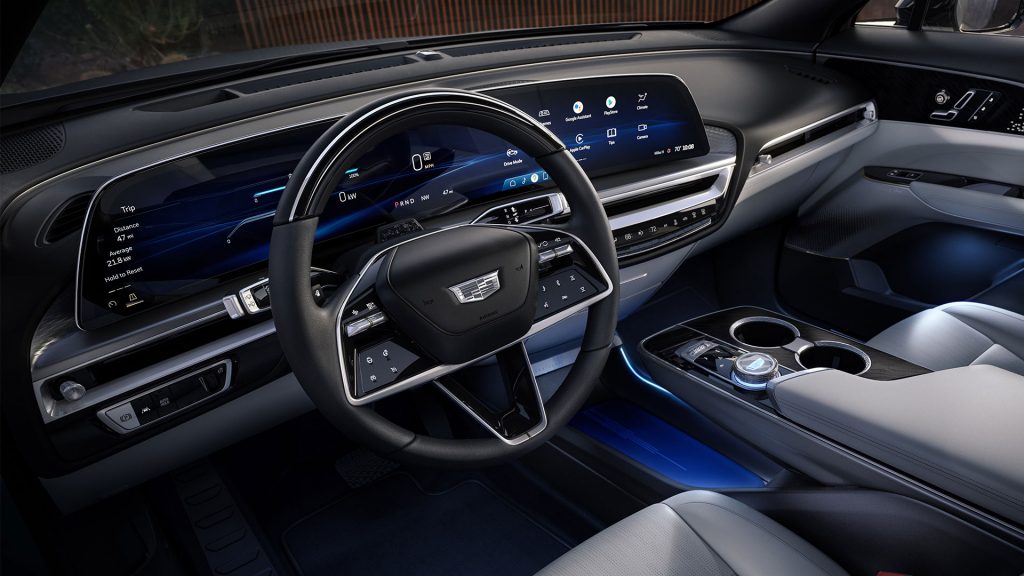
When the German Car of the Year awards were announced in October 2024, industry watchers might have been surprised to see an American luxury brand take home the coveted Luxury category title. The Cadillac LYRIQ’s victory marked a significant milestone for General Motors’ premium brand in one of the world’s most discerning automotive markets.
But for those familiar with what powers the LYRIQ’s stunning visual experience, the win wasn’t surprising at all.
When European Standards Meet American Innovation
Germany’s automotive market doesn’t hand out awards lightly. The country that gave us the Autobahn, BMW’s Ultimate Driving Machine and Mercedes-Benz’s engineering excellence has particular expectations when it comes to luxury vehicles. The LYRIQ’s triumph signals that American automotive technology has reached a new level of sophistication—one that European consumers and critics alike recognize as a winner.
At the heart of this recognition lies the vehicle’s commanding 33-inch diagonal LED display, a centerpiece that doesn’t just look impressive but delivers the kind of seamless, responsive performance that luxury buyers demand. This isn’t about flashy graphics for their own sake—it’s about creating an interface that feels as refined and dependable as the vehicle itself.
The Foundation of Excellence: Safety-Critical Software
Behind every smooth animation, every crisp rendering and every instantaneous response lies a fundamental truth that OEMs and Tier 1 suppliers understand: automotive displays aren’t consumer electronics. They’re safety-critical systems that must perform flawlessly under conditions that would cripple standard graphics solutions.
The LYRIQ’s display system, powered by Altia’s embedded graphics software, exemplifies this principle. When you’re designing for automotive applications, you can’t afford the luxury of “good enough.” Every pixel, every transition, every touch response must work perfectly whether the vehicle is sitting in a Helsinki winter at -20°F or baking in a Phoenix summer at 120°F.
This is where the distinction between consumer-grade apps and automotive-grade solutions becomes crystal clear. While consumer devices can tolerate occasional glitches or slowdowns, automotive systems demand unwavering reliability. The software managing the LYRIQ’s visual interface is subject to rigorous testing and validation just like the vehicle’s braking and steering systems—because in modern vehicles, the human-machine interface is equally critical to the driving experience.
Beautiful Graphics That Never Compromise Performance
The LYRIQ’s success in Germany demonstrates something that forward-thinking OEMs already understand: today’s luxury car buyers expect visual experiences that rival mobile phones, but with the reliability standards of mission-critical systems. This creates a unique challenge for embedded graphics tools.
Altia’s approach to this challenge focuses on three core principles that the LYRIQ exemplifies:
Visual Excellence Without Compromise: The graphics must be stunning—smooth animations, crisp fonts and responsive touch interactions that feel natural and immediate. But this visual polish cannot come at the expense of system stability or performance.
Hardware-Agnostic Performance: Different vehicle platforms, different processors, different display technologies—the graphics solution must deliver consistent excellence regardless of the underlying hardware. This flexibility allows OEMs to make platform decisions based on cost, availability and other business factors without sacrificing the user experience.
Deterministic Behavior: In safety-critical applications, unpredictability is unacceptable. The graphics system must behave consistently, with predictable memory usage, reliable real-time performance and graceful handling of edge cases.
The Competitive Advantage of Proven Technology
For OEMs evaluating their next-generation display strategies, the LYRIQ’s German recognition offers valuable insights. In a market where consumers have more luxury choices than ever, the quality of the digital experience has become a key differentiator. German buyers—known for their technical sophistication and quality expectations—validated that the LYRIQ’s interface meets the highest standards.
This validation didn’t happen by accident. It resulted from choosing embedded graphics technology that prioritizes reliability and performance over flashy features that might impress in demos but fail in real-world conditions. The LYRIQ’s success demonstrates that when you build on a foundation of safety-critical software principles, you can achieve both visual excellence and the rock-solid dependability that automotive applications demand.
Looking Forward: The New Standard for Automotive Graphics
The LYRIQ’s German Car of the Year recognition represents more than a single product success. It signals a new baseline for what luxury automotive displays can achieve. As the industry moves toward more sophisticated human-machine interfaces, software-defined vehicles and increasingly complex digital experiences, the fundamental requirements haven’t changed: safety, reliability and performance must come first.
For OEMs and Tier 1 suppliers planning their next-generation vehicles, the lesson is clear: the graphics solution you choose today will determine whether your product can compete in markets that demand both stunning visuals and unwavering reliability. In an industry where recalls cost millions and brand reputation takes years to build, that choice has never been more critical.
The Cadillac LYRIQ’s success in Germany proves that when you start with the right foundation—high-quality, safety-critical embedded graphics software—you can achieve results that surprise even the most discerning markets.
That Altia powers this award-winning experience? That shouldn’t surprise anyone who understands what it takes to succeed in automotive.
Recent Posts
- Germany’s Car of the Year May Surprise You. That Altia is Inside Shouldn’t.
- Buttons are Back—And It’s About Time
- Altia Named Best Workplace by Colorado Springs Gazette for Seventh Consecutive Year
- Altia ON: 2025 Dodge Charger Daytona EV
- Balancing Innovation with Compliance for Automotive HMI Applications